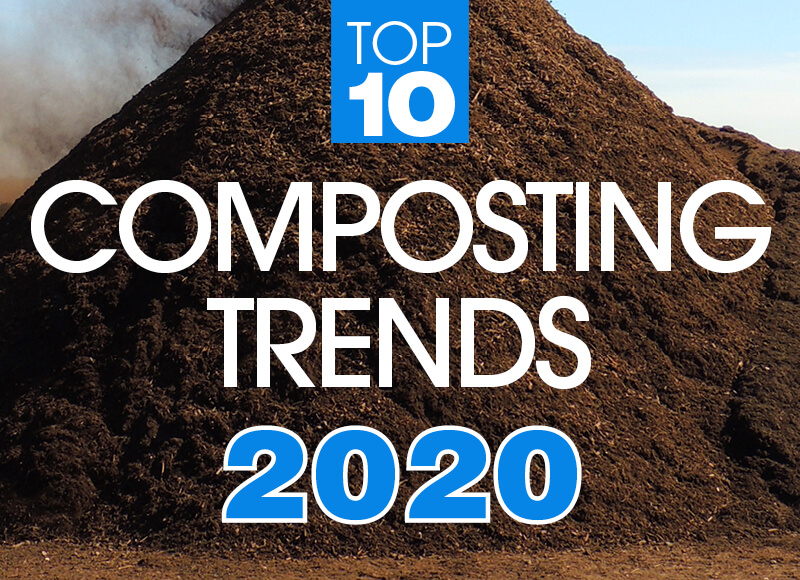Nora Goldstein & Craig Coker
At the end of 2019, BioCycle editors contacted national and regional composting stakeholders to ask about the 2 most important trends that influenced the composting industry in their region, or nationwide, in 2019 — and if they see those trends continuing in 2020. We also asked about new trends they are tracking in 2020, and if they see changes on the horizon that will offset or mitigate 2 major impediments — siting and financing — to developing new composting infrastructure. Finally, with the dawning of a new decade, we were curious about the single most significant advancement in the composting sector in the 2010s. And, of course, for a prediction: What will that advancement be in the 2020s?
We compiled the responses, and ranked the top 10 trends for both 2019, and heading into 2020.
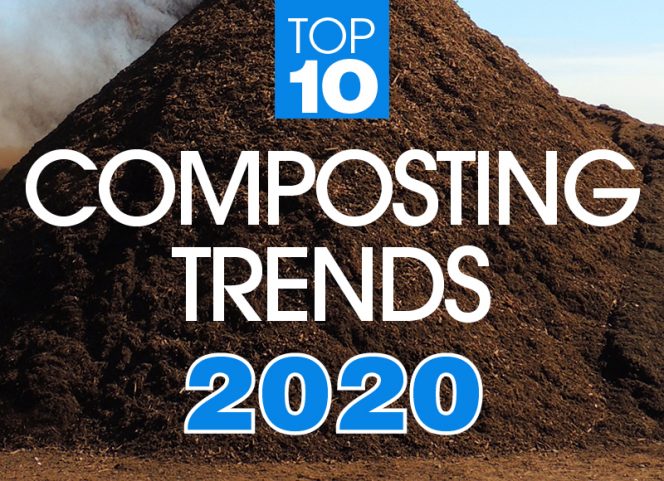 Top Ten Composting Trends
Top Ten Composting Trends
1. Organics out of the landfill mandates
Similar to the late 1980s and early 1990s, the 2010s showed that landfill disposal bans or mandates are effective tools to drive organics to composting and anaerobic digestion (AD) facilities.
2. Contamination — and dealing with it
Increased commercial and residential food waste recycling has also come along with increased contamination, especially from plastic film and packaging. This trend may increase as a result of mandatory disposal bans and the increase in collection programs. Facilities are equipped (or getting equipped) to manage that reality.
3. Advances in compost market development, including government agency procurement.
Carbon “farming” in California, state and local government compost procurement rules, and an overall emphasis on soil health are boosting compost markets. However, in some areas, development of multiple composting facilities in response to food waste bans and recycling pressures requires expansion of compost markets.
4. Feedstock commitments, or the lack thereof
Investors and lenders demand them, food waste generators don’t want to commit, and in some places, there is outright competition for feedstocks.
5. Compostable foodservice products
State and local packaging regulations and ordinances include compostable products — along with recyclable and reusable — as alternatives to banned single-use plastics. Yet composts made with compostable packaging are not certifiable for use in organic agriculture.
6. Reducing wasted food
Recognition of the huge volumes of wasted food skyrocketed in the 2010s. Source reduction and food recovery programs are being adopted. Organics recyclers manage what can’t be consumed.
7. Growth in residential food scraps collection and drop-off
The number of programs continue to increase via municipal and subscription service collection, and access to drop-off sites.
8. Multiple scales of composting
Community composting took off in the 2010s, launched in part by demand for better soils for community gardens and urban farms. In general, the barriers to entry are lower for smaller scale facilities.
9. PFAS
Poly-fluorinated compounds are the most recent plague for composters and other organics recyclers. The challenge — PFAS are ubiquitous, thus are commonly detected.
10. State composting regulation revisions
In the 2010s, and anticipated into the 2020s, more states are revising their composting rules to lighten and/or exempt smaller facilities from permitting requirements.
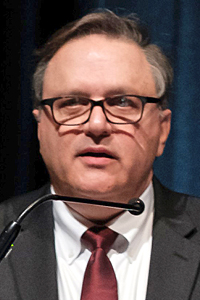
Frank Franciosi
National
Frank Franciosi, Executive Director, US Composting Council
Most significant advancement in the 2010s: Organics landfill bans had a great influence on jump starting composting in those states that had the vision to pass these bans. Sometimes the stick works faster than the carrot.
Compostable Products: We are seeing more companies at all levels looking at composting as a means to develop cradle-to-cradle products. This is strengthened by both consumer demand and stakeholder influence. The collapse of the overseas recycling markets has also made consumer brands look for alternatives in their product packaging. I believe we will see more compostable packaging, particularly in the consumer food products area, in the next 1-5 years. We also see states adopting model labeling requirements for compostable products — and predict there will be uniform color identification of these products in the next 1-2 years.
Regulations and templates: The trend to update state regulations seems to continue, and the USCC is updating its Model Rules Template. We also are working to create model zoning templates for compost manufacturing facilities. This tool would help municipalities consider compost manufacturing in their overall waste plan and carve out sites for this business.
Compost market development: The push for “green infrastructure” development in urban areas and the growing trend of regenerative agriculture created significant demand for compost products in the 2010s.
New England

Robert Spencer
Robert Spencer, Executive Director, Windham Solid Waste Management District, Brattleboro, Vermont
Most significant advancement in the 2010s: Mandatory food scraps recycling. Predicting we will see that continue, along with ratcheting down the thresholds of generators that need to comply to grow the volumes diverted.
Organics out of the landfill: Mandatory organics recycling is obviously a huge trend in New England, with 4 out of the 6 states adopting landfill diversion requirements. Vermont’s mandatory organics disposal ban (included in Act 148 adopted in 2012) has spawned new projects in the state. It really works. We’ve also seen that in Massachusetts, and soon to come in New York State, which passed a food waste disposal ban in 2019. Here in Vermont, all food waste must be diverted from landfill disposal on July 1, 2020. States have been prudent in taking a stepped approach to compliance with their bans to enable infrastructure capacity to develop — starting with larger generators and then gradually expanding to smaller generators.
Feedstock commitments: In the last 3 to 5 years, we’ve observed increasing installation of depackaging and anaerobic digestion facilities in New England states. They are either located together, or as a stand-alone depackaging facility, e.g., installed at a solid waste transfer station. Statewide and in New England, this is a positive game changer for diverting organics, however the ancillary effect is that there is diversion away from composting. Here in Brattleboro, for example, the District’s composting operation lost 2 supermarkets it was servicing. There is competition for organics now. We saw that in Europe 10 years ago with AD facilities paying for materials.
In general, we can’t get generators to contract to use composting or AD facilities. And banks look for long-term contracts. We don’t see a lot of haulers entering this space for that reason. In my opinion it is the biggest challenge, not just to facility financing, but to overall project viability.
Compost procurement: Anticipate local governments and states having procurement policies — we’ve seen some huge improvements. Vermont is already doing it slowly.
PFAS: Our solid waste district was asked by the state if we would consider testing our compost for PFAS (per- and polyfluoroalkyl substances). I said yes, but only when there is a state standard for specific PFAS compounds for soil and for compost, and secondly, an approved methodology for testing.
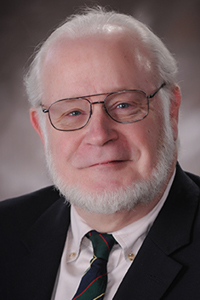
Craig Coker
Mid-Atlantic
Craig Coker, BioCycle CONNECT and Coker Composting & Consulting
Most significant advancement in the 2010s: Evolution of community-scale composting facilities driven in large part by the high cost of land in the mid-Atlantic states.
Financing: While it is still very difficult to secure bank-based debt financing for composting and AD facilities in the absence of both feedstock intake and product offtake agreements, there is a renewed interest by smaller-scale, private-equity financiers to learn more about organics recycling and to make patient investments in growing companies and in new projects provided they can realize 15% to 18% return on investment (ROI). Start-up capital is still hard to find.
Compost markets: There is growing interest to develop new composting facilities throughout the mid-Atlantic, but, to date, there has not yet been any governmental influence to encourage compost markets. This creates a potential future risk of product oversupply in some areas.
Scale of composting: Growth in community-scale composting facilities is likely to continue. States are beginning to develop realistic permitting and regulatory approaches to facilitate this trend.
Midwest—Illinois
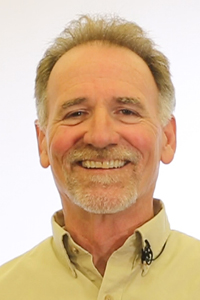
Walter Willis
Walter Willis, Executive Director of the Solid Waste Agency of Lake County, Illinois; Board Member, Illinois Food Scrap Coalition (IFSC)
Most significant advancement in the 2010s: Enactment of a law that allowed landscape waste composting facilities to accept food scraps.
Organics out of the landfill: In Illinois, which doesn’t have mandatory food scraps diversion rules, the most significant development in the 2010s was enactment of a law that allowed landscape waste (yard trimmings) composting facilities to accept food scraps without going through costly local siting and permitting processes. This provided the necessary infrastructure to allow for collection programs to proliferate. As for the 2020s, at some point we may realize that food scrap diversion programs in Illinois need state legislation to ban food scraps from the landfill in order to really move the needle on organics diversion. This would be very controversial, with a strong network of privately owned landfills that would not be in favor of losing 20% to 30% of their volume to composting sites. Because voluntary programs take a tremendous amount of time to develop and nurture, a state law banning organics from the landfill in some manner would be a significant advancement for composting in Illinois.
Reducing wasted food: One of the most important trends in 2019, and heading into 2020, is the growing recognition about our country’s wasted food problem and the need to recover what we can for human consumption, but compost what we can’t recover. I do see continued collaboration with food recovery organizations to address the wasted food problem. Those connections are getting stronger.
Food scrap collection, contamination: There has been continued growth, albeit slowly, of commercial and residential food scrap collection programs in Illinois. We are up to over 40 municipalities with either 8 month or year-round programs and hundreds of businesses and institutions. We want to make sure as we grow access to food scrap collection programs for both the residential and commercial sectors that we continue to focus on education, education, education. As more material is diverted, the risk for contamination increases. Being proactive will be important. We can’t have composting sites getting frustrated with contamination and back away from accepting food scraps.
Compost procurement: The IFSC will be actively tracking use of compost at two Illinois Department of Transportation (IL DOT) road projects in 2020. This was the result of a state law that requires the use and study of compost on two projects, and requires the IL DOT to submit a report to the General Assembly within one year of the projects being completed, addressing the benefits and costs associated with compost use at the projects. The goal is to continue to grow use of compost in IL DOT projects. Market development continues to be an essential element to growing food scrap diversion programs.
Feedstock commitments: One big impediment is lack of a committed feedstock (i.e., organic material) for new facilities. We have had efforts to use existing municipal wastewater anaerobic digesters in our region to manage food scraps, but figuring out how to get the food scraps to the digester in the form and volume the digester wants has been the downfall of this effort. There isn’t enough supply out there being collected to create the demand for new facilities or to utilize existing facilities such as wastewater digesters.
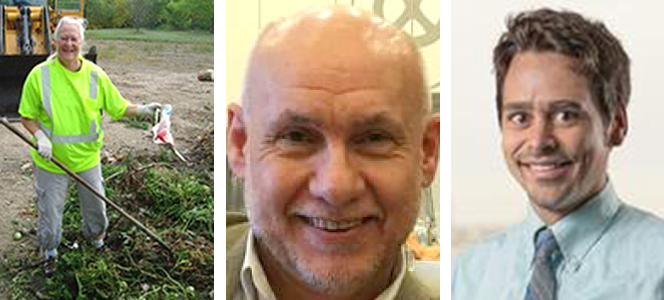
Ginny Black, Tim Goodman and Jon Klapperich
Midwest—Minnesota
Ginny Black, Chair, Tim Goodman, Board Member, and Jon Klapperich, Board Member, Minnesota Composting Council (MNCC)
Most significant advancement in the 2010s: A successful curbside organics collection program in Minneapolis, the state’s most populous city.
Organics out of the landfill: The Minnesota legislature mandated a 75% recycling goal by 2030 in the 7-county metropolitan area that includes Minneapolis and St. Paul. The higher goal cannot be met unless organics collection is incorporated into the recycling programs. We are seeing growth in the number of residential curbside and drop-off organics programs as a result.
Compostable products: The increase in organics collection is leading states and local governments to adopt packaging laws/ordinances that require compostable plastic to be labeled to increase identification by consumers. This may include stripes, markings, coloration, tinting and texture. The MNCC is working with authors of legislation in the Minnesota state house to amend a state law that addresses the packaging labeling issue. Overall, in the 2010s, compostable plastics have finally made a significant presence in the marketplace. This has the possibility of reducing contamination in finished compost, which will hopefully increase the sale price.
PFAS: An issue percolating to the top is PFAS at composting facilities. The Minnesota Pollution Control Agency (MPCA) has tested storm water at a yard trimmings site and a yard trimmings/food waste composting site and found PFAS at both. The source of those chemicals is unknown at this time. However, the presence has resulted in the MPCA requiring storm water from yard trimmings/food waste (source separated organic materials) composting sites be trucked to wastewater treatment plants. This has added significant cost to the operation of some Minnesota composting facilities.
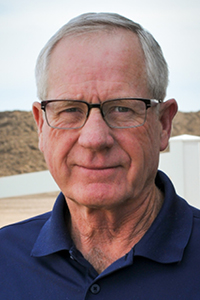 Rocky Mountain States
Rocky Mountain States
Bob Yost, A-1 Organics, Eaton, Colorado
Most significant advancement in the 2010s: Significant increased focus on food waste composting and landfill diversion of organics with a lot of new interest in sustainability by local governments.
Composting and AD: On the composting technical side, there has been more focus on the biology of composting. I expect more of the same in the 2020s, along with a focus on residential diversion. I would like to see more diversion to anaerobic digesters for the renewable energy value of the food wastes. We are expecting a lot of growth in the ability of dewatered digestate solids to be a marketable product.
Compost markets: Governments and industries need to embrace the circular economy to encourage compost use. We are working with our municipal clients to ensure they buy back volumes of compost equal to the volumes of compostables they send to us for processing. We are seeing a potential big jump in compost sales to hemp farmers and are encouraged by the Colorado Department of Agriculture’s new Colorado Healthy Soil Initiatives that incentivize farmers to adopt carbon and water conserving practices by managing for healthy soil.
Legislation and regulations: On a positive note, there are more legislative efforts to mitigate costs of developing composting facilities, increasing markets for compost, and to increase the available grant monies. However, the regulations are still difficult to deal with for commercial composting operations. Confusion and discrepancies between different agency requirements (Solid Waste, Ag, Oil and Gas, etc.) related to compost use and compost production are also problematic. In the Mountain states, we have to deal with “technologically enhanced normally occurring radioactive materials” (TENORM), which are enhanced by the flocculation systems in potable water plants, the residuals from which we have been taking as a feedstock on a limited basis. Colorado’s Health Department will be replacing a previous “Guidance Document” with regulations in 2020 setting limits on TENORM, which are going to raise processing costs for nonexempt tier levels due to additional testing requirements. Concern over illogical or unscientific effects of PFAS in compost also are a concern.
Pacific Northwest
 Sally Brown, University of Washington
Sally Brown, University of Washington
Most significant advancement in the 2010s: In the Northwest, a big thing is that diversion to composting is normal. It is now just what we do.
Compost procurement: Our local county is having problems integrating compost use into the county infrastructure. So it is trying to figure out how to focus on compost quality and actually using the stuff that we are all gung ho to make.
Contamination: The county did a limited survey of households and food scrap composting, e.g., what is percentage rate of participation, the level of contaminants, etc. People all know to compost but the intricacies of what goes in and what doesn’t aren’t obvious — they err on the side of putting in anything that might be compostable to do a really good job at participating. The county wants them to leave any questionable stuff out. How do you transition to a system where enough of the packaging is sustainable so that you can really do a good job with making compost? And then how do you transition to a system where compost use is just what you do?

Tim O’Neill
Tim O’Neill, Engineered Compost Systems
Most significant advancement in the 2010s: In the 2010s, investments and initiatives in organics recycling were substantially diverted from new composting capability to anaerobic digestion.
Managing air emissions: The nascent awareness that air emissions from composting facilities (odors and VOCs) are driven by process conditions and that, in most cases, it is more cost-effective and sustainable to focus on improving those conditions than it is to enclose a facility.
Composting infrastructure: The experience during this past decade has led to a narrower focusing of AD applications and a re-expansion of the role of composting in the broader organics recycling market. All indications are that this trend will continue into the 2020s.
California

Matt Cotton
Matt Cotton, Integrated Waste Management Consulting
Most significant advancement in the 2010s: Availability of high-quality compost operator training has been the single biggest advancement for the composting industry.
Infrastructure and contamination: California’s SB 1383 is top of mind for the region’s composters, though collection programs are coming on-line more slowly than hoped. However, progressive composters are installing preprocessing equipment, either picking stations or depackaging equipment. I expect more facilities to invest in upfront contaminant removal in 2020 as more food scraps programs come online.
Compost markets: California is making real advances to bring the science of carbon sequestration or carbon farming to the real world of compost markets. Early results are encouraging, and we may see jurisdictions, with significant procurement requirements under SB 1383, looking to carbon farming as one way to meet those requirements. More upfront processing (for contaminant management) and more finished compost used for carbon sequestration will continue to grow in 2020.
Organics out of the landfill: Regulatory drivers (landfill bans, strong recycling goals, etc.) have been the single biggest driver of new composting facilities in the U.S. I expect, as we continue to learn about climate change, that more states and jurisdictions will ban food scraps from landfills in the 2020s as they did in the late 1980’s early 1990s. We are learning more about the challenges of methane emissions from landfills, and fortunately, keeping organics out of landfills is proven and easily achievable by most communities.
Training: Since 2010, the USCC’s Compost Operator Training Program has advanced the composting industry. I strongly believe trained operators are better operators, making better products with less impacts on the community.


